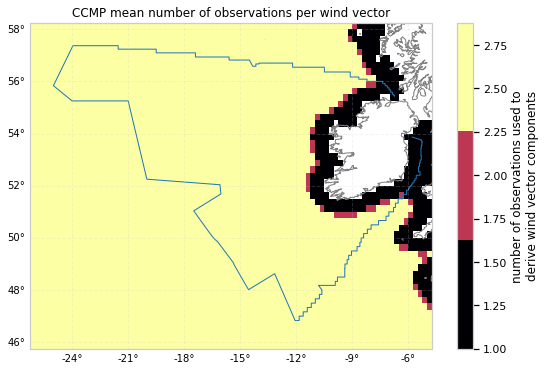CCMP Wind Data for Irish Continental Shelf region
Contents
CCMP Wind Data for Irish Continental Shelf region¶
Introduction¶
Cross-Calibrated Multi-Platform (CCMP) is a Level-3 gridded ocean surface vector wind analysis data set produced using satellite, moored buoy, and model wind data. The original CCMP product (V1.1) was produced with funding from the NASA REASoN and MEaSUREs programs, while the V2.x versions are generated by Remote Sensing Systems (RSS). Further details and example usage may be found in the following publications:
This notebook provides details of:
CCMP wind data products retrieval.
The creation of the CCMP Zarr wind store that is included in the EOOffshore catalog.
A brief look at this Zarr store, including a demonstration of wind speed calculation.
This CCMP Zarr store has been uploaded to Zenodo.
How to cite:
O’Callaghan, D. and McBreen, S.: Scalable Offshore Wind Analysis With Pangeo, EGU General Assembly 2022, Vienna, Austria, 23–27 May 2022, EGU22-2746, https://doi.org/10.5194/egusphere-egu22-2746, 2022.
O’Callaghan, D. and McBreen, S.: EOOffshore: CCMP v0.2.1.NRT Wind Data for the Irish Continental Shelf Region, (1.0.0) [Data set], Zenodo, 2022.
Note: more extensive usage of the EOOffshore CCMP Zarr store may be found in the following notebooks:
CCMP Wind Data Products¶
RSS CCMP data products are publicly available via HTTPS. The EOOffshore project uses the V2.1 Near Real Time (NRT) products, which provide 6-hourly data from 2015 to the present day. V2.1 NRT was used as the most recent products for the alternative V2.0 and V2.0 NRT versions cover dates to 2019 and 2020 respectively. As discussed by Mears et al. (2019), CCMP‐NRT products are routinely processed with a latency of less than 48 hours. The following relevant variables are provided:
Variable |
Unit |
Height (metres above sea level) |
Description |
|---|---|---|---|
|
\(m s^{-1}\) |
10 |
U (eastward) wind component |
|
\(m s^{-1}\) |
10 |
V (northward) wind component |
|
Dimensionless |
n/a |
Number of observations used to derive wind vector components |
Daily global products containing these variables were retrieved:
Observation / Models |
Satellite/In Situ/Model |
Product type |
Near-Real-Time |
Processing level |
Level-3 |
Data type |
Gridded |
Coordinate reference system |
WGS 84 / Plate Carree (EPSG 32662) |
Horizontal coverage |
Global |
Horizontal resolution |
0.25° × 0.25° |
Vertical coverage |
Single level |
Temporal coverage |
2015-01-16T00:00:00 to 2021-09-30T18:00:00 |
Temporal resolution |
6-Hourly (00, 06, 12, 18Z) |
Update frequency |
Daily (~48 hour latency) |
File format |
NetCDF-4 |
Total retrieved products |
2,436 |
Total products size |
109G |
CCMP Wind Zarr Store¶
The retrieved NetCDF products were loaded using xarray.open_mfdataset(), combined by their grid coordinates and concatenated along the time dimension. A preprocessor function selected coordinates for the Irish Continental Shelf (ICS) region and computed the following new variables from those contained in the CCMP products, using MetPy functions decorated with @dask.delayed for lazy execution by Dask:
Variable |
Unit |
Height (meters above sea level) |
Description |
|---|---|---|---|
|
\(m s^{-1}\) |
10 |
Wind speed calculated from U and V wind components with |
|
degree |
10 |
Wind direction calculated from U and V wind components with |
A height dimension was also added for these new 10m variables. The data set was persisted to a single, chunked, compressed Zarr store (525M), which is a cloud-optimised format suitable for multi-dimensional arrays. Retaining only the ICS coordinates results in considerably lower storage requirements compared to the original products that were retrieved. A time chunk size was specified that resulted in a low number of time chunks, as this approach is more suitable for subsequent processing of variables over time for Areas Of Interest (AOIs).
CCMP in EOOffshore Catalog¶
Imports required for subsequent processing
%matplotlib inline
import cartopy.crs as ccrs
from intake import open_catalog
import json
import matplotlib as mpl
import matplotlib.pyplot as plt
import seaborn as sns
import shapely.geometry as sgeom
sns.set_style('whitegrid', {'axes.labelcolor': '0', "text.color": '0', 'xtick.color': '0', 'ytick.color': '0', 'font.sans-serif': ['DejaVu Sans', 'Liberation Sans', 'Bitstream Vera Sans', 'sans-serif'],})
sns.set_context('notebook', font_scale=1)
Open the catalog and view the CCMP metadata¶
All EOOffshore data sets, including the CCMP Zarr store described above, are accessible using the EOOffshore Intake catalog. Each catalog entry provides a description and metadata associated with the corresponding data set, defined in a YAML configuration file. The EOOffshore catalog configuration was originally influenced by the Pangeo Cloud Data Store atmosphere.yaml catalog configuration.
To view the CCMP metadata:
catalog = open_catalog('data/intake-catalogs/eooffshore_ics.yaml')
catalog.eooffshore_ics_ccmp_v02_1_nrt_wind
eooffshore_ics_ccmp_v02_1_nrt_wind:
args:
storage_options: null
urlpath: /data/eo/zarr/ccmp/v02.1.NRT/eooffshore_ics_ccmp_v02_1_nrt_wind.zarr
description: EOOffshore Project 2015 - 2021 Concatenated CCMP v0.2.1.NRT 6-hourly
wind products provided by Remote Sensing Systems (RSS), for Irish Continental
Shelf. Wind speed and direction have been calculated from the uwnd and vwnd variables.
CCMP Version-2.0 vector wind analyses are produced by Remote Sensing Systems.
Data are available at www.remss.com.
driver: intake_xarray.xzarr.ZarrSource
metadata:
catalog_dir: /opt/eooffshore/notebooks/datasets/data/intake-catalogs/
tags:
- atmosphere
- wind
- ccmp
- ocean
title: EOOffshore Project 2015 - 2021 Concatenated CCMP v0.2.1.NRT 6-hourly wind
products provided by Remote Sensing Systems (RSS), for Irish Continental Shelf
url: https://www.remss.com/measurements/ccmp/
Load the catalog CCMP Zarr store¶
Intake catalog entries typically specify a driver to be used when loading the corresponding data set. The CCMP entry specifies intake_xarray.xzarr.ZarrSource, a driver implementation provided by the intake-xarray library. This enables NetCDF and Zarr data sets to be loaded using xarray, a library for processing N-D labeled arrays and datasets. As xarray labels take the form of dimensions, coordinates and attributes on top of NumPy-like arrays, it is particularly suited to data sets such as CCMP whose variables feature latitude/longitude grid coordinates.
This intake driver will load the associated dataset into an xarray.Dataset. To enable support for potentially large data sets, the to_dask() function is used to load the underlying variable arrays with Dask, a parallel, out-of-core computing library. The ZarrSource implementation will load the data set variables into Dask arrays, which will be loaded and processed in parallel as chunks during subsequent computation. As discussed above, variable chunk sizes may be specified during Zarr store creation.
Here is the CCMP store loaded into an xarray.Dataset:
All variables have associated coordinate dimensions:
time- hourlylatitudeandlongitude- the corresponding coordinate grid
The
wind_speedandwind_directionvariables have aheightcoordinate dimension, reflecting the 10m (above sea level) variables in the products retrieved from RSS.A low number of
timechunks have been specified, to support subsequent computation across time for smaller AOI grid coordinates.
ds = catalog.eooffshore_ics_ccmp_v02_1_nrt_wind.to_dask()
ds
<xarray.Dataset>
Dimensions: (height: 1, latitude: 50, longitude: 86, time: 9744)
Coordinates:
* height (height) int64 10
* latitude (latitude) float32 45.88 46.12 46.38 ... 57.62 57.88 58.12
* longitude (longitude) float32 333.9 334.1 334.4 ... 354.6 354.9 355.1
* time (time) datetime64[ns] 2015-01-16 ... 2021-09-30T18:00:00
Data variables:
nobs (time, latitude, longitude) float32 dask.array<chunksize=(8000, 50, 86), meta=np.ndarray>
uwnd (time, latitude, longitude) float32 dask.array<chunksize=(8000, 50, 86), meta=np.ndarray>
vwnd (time, latitude, longitude) float32 dask.array<chunksize=(8000, 50, 86), meta=np.ndarray>
wind_direction (height, time, latitude, longitude) float32 dask.array<chunksize=(1, 8000, 50, 86), meta=np.ndarray>
wind_speed (height, time, latitude, longitude) float32 dask.array<chunksize=(1, 8000, 50, 86), meta=np.ndarray>
Attributes: (12/35)
Conventions: CF-1.6
comment: none
contact: Remote Sensing Systems, support@remss.com
contributor_name: Carl Mears, Joel Scott, Frank Wentz, Ross...
contributor_role: Co-Investigator, Software Engineer, Proje...
creator_email: support@remss.com
... ...
publisher_email: support@remss.com
publisher_name: Remote Sensing Systems
publisher_url: http://www.remss.com/
references: Mears et al., Journal of Geophysical Rese...
summary: CCMP_RT V2.1 has been created using the s...
title: RSS CCMP_RT V2.1 derived surface winds (L...Observations used to derive CCMP wind vector components¶
CCMP provides a nobs variable, which contains the number of observations used to derive each coordinate’s wind vector components at a particular time
Each variable in the CCMP data set, including nobs, is loaded into an xarray.DataArray:
ds.nobs
<xarray.DataArray 'nobs' (time: 9744, latitude: 50, longitude: 86)>
dask.array<open_dataset-9fd918ad6306c980345117750e2a0290nobs, shape=(9744, 50, 86), dtype=float32, chunksize=(8000, 50, 86), chunktype=numpy.ndarray>
Coordinates:
* latitude (latitude) float32 45.88 46.12 46.38 46.62 ... 57.62 57.88 58.12
* longitude (longitude) float32 333.9 334.1 334.4 334.6 ... 354.6 354.9 355.1
* time (time) datetime64[ns] 2015-01-16 ... 2021-09-30T18:00:00
Attributes:
ancillary_variables: uwnd vwnd
long_name: number of observations used to derive wind vector c...
standard_name: number_of_observations
valid_max: 100.0
valid_min: 0.0Filter wind data, ensuring at least one observation was used at each time¶
ds = ds.where(ds.nobs >= 1)
Plot the mean (over time dimension) number of observations used to derive the wind components¶
Using Dask, the data set loading process is lazy, where no data is loaded inititally. Instead, data loading is delayed until execution time, where variables will be loaded and processed in parallel according to the corresponding chunks specification. Dask arrays implement a subset of the NumPy ndarray interface using blocked algorithms, and the original variable arrays will be split into smaller chunk arrays, enabling computation on arrays larger than memory using all available cores. The blocked algorithms are coordinated using Dask graphs.
Here, mean nobs over the time dimension is initially determined for all grid coordinates, where Dask graph execution is triggered by calling compute(). The resulting variable values will be contained in a NumPy ndarray.
Graph execution is managed by a task scheduler. The default scheduler (used for executing this notebook) executes computations with local threads. However, execution may also be performed on a distributed cluster without any change to the xarray code used here.
mean_nobs = ds.nobs.mean(dim='time', keep_attrs=True).compute()
mean_nobs
<xarray.DataArray 'nobs' (latitude: 50, longitude: 86)>
array([[2.6420267, 2.638732 , 2.6289637, ..., 2.4409888, 2.447983 ,
2.449444 ],
[2.6423347, 2.6310947, 2.6322517, ..., 2.4487145, 2.4491937,
2.4605367],
[2.6355782, 2.6272976, 2.6442015, ..., 2.47293 , 2.46377 ,
2.4566014],
...,
[2.8631635, 2.8629775, 2.8558607, ..., nan, nan,
nan],
[2.8681824, 2.874703 , 2.8699908, ..., nan, nan,
nan],
[2.8786166, 2.8761842, 2.8665617, ..., nan, nan,
nan]], dtype=float32)
Coordinates:
* latitude (latitude) float32 45.88 46.12 46.38 46.62 ... 57.62 57.88 58.12
* longitude (longitude) float32 333.9 334.1 334.4 334.6 ... 354.6 354.9 355.1
Attributes:
ancillary_variables: uwnd vwnd
long_name: number of observations used to derive wind vector c...
standard_name: number_of_observations
valid_max: 100.0
valid_min: 0.0Map plots of variables with grid coordinates may be generated using xarray’s plotting capabilities, and other libraries. To plot the mean number of CCMP observations:
Specify a suitable projection using Cartopy
Call the variable
xarray.DataArray.plot()Load the ICS maritime limits geometry with Shapely
Specifying a Cartopy projection will use a
GeoAxes, which is a subclass of a regular matplotlibAxes. This may be used to plot the following:ICS boundary
Variable grid (latitude/longitude) lines
Ireland coastline
with open('data/linestring_ics_geo.json') as jf:
icsgeo = json.load(jf)
icsline = sgeom.LineString(icsgeo['features'][0]['geometry']['coordinates'])
MAP_PROJECTION = ccrs.PlateCarree()
fig, ax = plt.subplots(figsize=(9, 6), subplot_kw=dict(projection=MAP_PROJECTION))
mean_nobs.plot(cmap=plt.cm.get_cmap('inferno', 3), vmin=mean_nobs.min(), vmax=mean_nobs.max(), ax=ax)
ax.set_aspect('auto')
# ICS boundary
ax.add_geometries([icsline], MAP_PROJECTION, edgecolor = sns.color_palette()[0], facecolor='none')
# Lat/lon gridlines
gl = ax.gridlines(draw_labels=['left', 'bottom'], alpha=0.2, linestyle='--', formatter_kwargs=dict(direction_label=False))
label_style = {'size': 10}
gl.xlabel_style = label_style
gl.ylabel_style = label_style
ax.coastlines(color='grey')
ax.set_title('CCMP mean number of observations per wind vector');

CCMP wind speed (2015 - 2021)¶
Wind speed is loaded into an xarray.DataArray:
ds.wind_speed
<xarray.DataArray 'wind_speed' (height: 1, time: 9744, latitude: 50,
longitude: 86)>
dask.array<where, shape=(1, 9744, 50, 86), dtype=float32, chunksize=(1, 8000, 50, 86), chunktype=numpy.ndarray>
Coordinates:
* height (height) int64 10
* latitude (latitude) float32 45.88 46.12 46.38 46.62 ... 57.62 57.88 58.12
* longitude (longitude) float32 333.9 334.1 334.4 334.6 ... 354.6 354.9 355.1
* time (time) datetime64[ns] 2015-01-16 ... 2021-09-30T18:00:00
Attributes:
long_name: Wind speed
units: m s**-1Calculate mean wind speed over time dimension at AOI grid coordinates¶
To perform some analysis at known AOI latitude/longitude coordinates, the xarray.DataArray.sel(..., method='nearest') function may be used to select a subset of the data array (or data set) at coordinates nearest to the specified parameters. Here, mean wind speed over the time dimension is determined for the specified coordinates.
ds.wind_speed.sel(longitude=-5.4302, latitude=53.4836, method='nearest').mean(dim='time').compute()
<xarray.DataArray 'wind_speed' (height: 1)>
array([10.082178], dtype=float32)
Coordinates:
* height (height) int64 10
latitude float32 53.38
longitude float32 333.9


